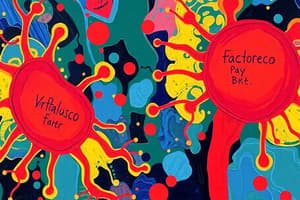Podcast
Questions and Answers
Which genus of aerobic cocci is known for producing enterotoxins?
Which genus of aerobic cocci is known for producing enterotoxins?
- Streptococcus
- Leuconostoc
- Staphylococcus (correct)
- Micrococcus
What is the characteristic arrangement of Streptococcus species?
What is the characteristic arrangement of Streptococcus species?
- Chains (correct)
- Clusters
- Pairs
- Tetrads
Which genus is indicated as an indicator for fecal contamination?
Which genus is indicated as an indicator for fecal contamination?
- Micrococcus
- Enterococcus (correct)
- Pediococcus
- Staphylococcus
Which genus includes organisms that are known for producing lactic acid from carbohydrates?
Which genus includes organisms that are known for producing lactic acid from carbohydrates?
What is the arrangement characteristic of the genus Sarcina?
What is the arrangement characteristic of the genus Sarcina?
Which of the following genera is associated with high salt tolerance?
Which of the following genera is associated with high salt tolerance?
What type of fermentation does Leuconostoc perform?
What type of fermentation does Leuconostoc perform?
Which bacteria are characterized as cocobacilli and are aerobic?
Which bacteria are characterized as cocobacilli and are aerobic?
Study Notes
Cocci Overview
- Cocci are spherical-shaped bacteria, characterized by distinctive cell arrangements.
Gram-Positive Cocci
- Aerobic Gram-positive cocci include several important genera and features.
Genus Streptococcus
- Pathogenic species: Streptococcus pyogenes known for causing diseases.
- Food processing species: Streptococcus thermophilus used in dairy, particularly for spoilage control.
- Arranged in chain formations.
Genus Enterococcus
- Serves as an indicator for fecal contamination.
- Commonly found in the intestinal tracts of humans and animals.
- Exhibits small chains in its arrangement.
Genus Micrococcus
-
Salt tolerant (up to ~3%), found on skin and in cured meats.
-
Produces spoilage bacteria and typically forms in tetrads.
-
Anaerobic Gram-positive cocci include facultative or obligate anaerobes.
Genus Staphylococcus
- Exhibits facultative anaerobic characteristics and is salt tolerant (up to ~15%).
- Known for producing enterotoxins that are heat-resistant.
- Capable of acid production without gas (homofermentative from carbohydrates).
- Commonly present on skin (Staphylococcus epidermidis) and in the nasal cavity.
- Arranged in clusters resembling grapes.
Genus Pediococcus
- A type of lactic acid bacteria, also facultative.
- Frequently used in dairy as a starter culture.
- Homofermentative, producing mainly acids from carbohydrates.
- Arranged in pairs or tetrads.
Genus Leuconostoc
- Another facultative anaerobe involved in fermentation.
- Characterized as heterofermentative, producing carbon dioxide and acids.
- Arranged in pairs or tetrads.
Genus Sarcina
- Strictly anaerobic with a pH tolerance from 2 to 9.
- Forms distinctive arrangements in tubes, typically seen as bundles of eight.
Gram-Negative Cocci
- Gram-negative cocci include aerobic and non-food-related anaerobes.
Aerobic Gram-Negative Cocci
-
Genus Moraxella: positive oxidase reaction.
-
Genus Acinetobacter: negative oxidase reaction.
-
Both are cocobacilli, being Gram-negative and aerobic.
-
Anaerobic Gram-negative cocci are not commonly found in food environments.
Studying That Suits You
Use AI to generate personalized quizzes and flashcards to suit your learning preferences.
Description
This quiz explores the classification of cocci bacteria, focusing on their arrangements and key genera such as Streptococcus, Enterococcus, and Micrococcus. Understand the distinctions between aerobic and anaerobic cocci, as well as their roles in food processing and pathogenicity. Test your knowledge on the unique characteristics of these spherical bacteria.




